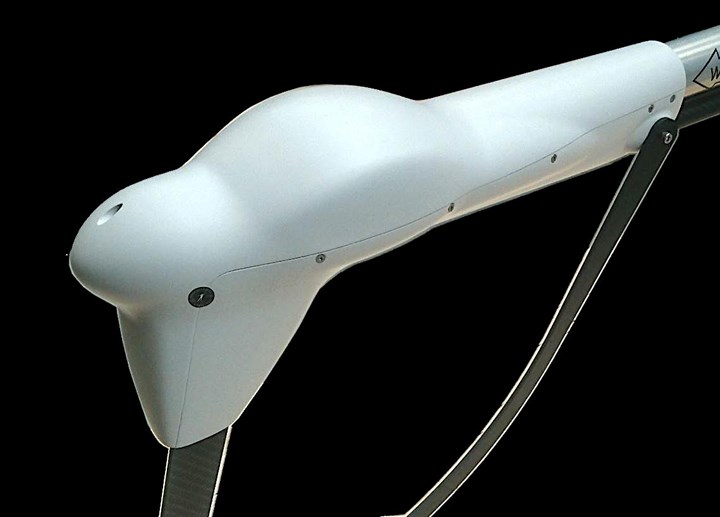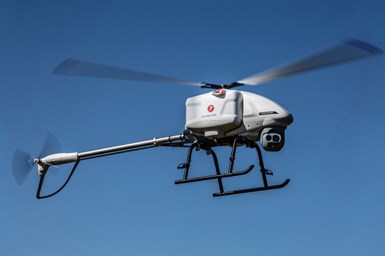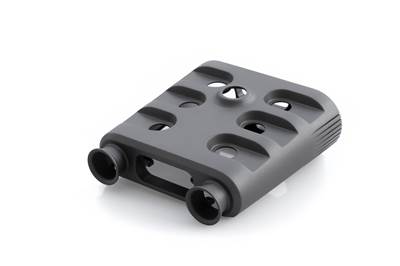3D-printed composite tail rotor gear box housing enhances Discovery super drone
CFP Technology teams with Flying-Cam to create 3D-printed, functional tail rotor actuators protection using Windform XT 2.0 composites and a powder bed fusion process.
CRP Technology’s (Modena, Italy) long-term collaboration with unmanned airborne solutions developer Flying-Cam (Belgium) has resulted in the construction of the UAV Discovery’s tail rotor gear box housing — the main housing attached to the main tail boon. The flight-ready part is 3D-printed (powder bed fusion/PFB) using CRP’s Windform XT 2.0 composite material.
Discovery is a 75-kilogram maximum takeoff weight (MTOW) unmanned single-rotor helicopter. It is Flying-Cam’s newest, largest and most versatile system so far with increased endurance features. Fully integrated state-of-art sensors were carefully chosen to match the platform quality for a variety of applications ranging from entertainment, homeland security, earth monitoring and high-precision remote sensing generally.
“With the potential drones offer the civil market, and the interest in beyond visual line of sight [BVLOS] flights, we felt it was the right time to develop a drone that could not only capture beautiful imagery for movies, television shows and commercials, but that could carry a variety of payloads to collect the necessary data for other industrial applications,” Emmanuel Previnaire, founder and CEO of Flying-Cam, says.
The aim of the “super drone” project was to create a lightweight yet rigid physical and aerodynamic protection for the tail rotor actuators and the GPS antenna. Flying-Cam opted for CRP Technology’s proprietary high-performance Windform Top-Line range of composite materials, particularly Windform XT 2.0, a carbon fiber-filled polyamide-based 3D printing composite especially suitable in demanding applications for such a sector as motorsports, aerospace and UAV.
The material replaced the previous formula of Windform XT in the Windform Top-Line family of materials for PBF created by CRP Technology, featuring improvements in mechanical properties including +8% increase in tensile strength, +22% in tensile modulus and a +46% increase in elongation at break.
“The component was planned to be clamped on the tail boom, and also support the carbon [fiber] plate used as a tail rotor ground protection,” Previnaire notes. “For this reason, a good stress resistance was needed. We chose Windform XT 2.0 as it allows us to achieve a good weight-resistance ratio.” Moreover, the mechanical and thermal properties of Windform materials are strictly connected to the characteristics of the 3D printing process.
“The most innovative aspect in enlisting the 3D printing process and composite materials supplied by CRP Technology, is the free shape design, important for aerodynamic purpose, as well as the ability to create complex wiring channels inside with strong attachment points, in one unique piece,” Previnaire underlines. “More specifically, the PBF process and Windform materials are said to enable the creation of hollow parts with a lot of functional details, such as fixation nuts integration, cable attachment points.”
“We started collaborating with CRP Technology many years ago, for the realization of SARAH 3.0, our electric vertical takeoff and landing [eVTOL] unmanned aerial system, now replaced by SARAH 4.0,” Previnaire adds. “CRP Technology 3D printed the airframe structure, air guide cooling system, tail unit and main battery connection.”
SARAH, as well as Discovery, is reported to be a cutting-edge “unmanned aerial intelligence” solution and only possible by mastering all the technologies and skills involved.
Related Content
TU Munich develops cuboidal conformable tanks using carbon fiber composites for increased hydrogen storage
Flat tank enabling standard platform for BEV and FCEV uses thermoplastic and thermoset composites, overwrapped skeleton design in pursuit of 25% more H2 storage.
Read MoreThe next evolution in AFP
Automated fiber placement develops into more compact, flexible, modular and digitized systems with multi-material and process capabilities.
Read MoreATLAM combines composite tape laying, large-scale thermoplastic 3D printing in one printhead
CEAD, GKN Aerospace Deutschland and TU Munich enable additive manufacturing of large composite tools and parts with low CTE and high mechanical properties.
Read MoreSulapac introduces Sulapac Flow 1.7 to replace PLA, ABS and PP in FDM, FGF
Available as filament and granules for extrusion, new wood composite matches properties yet is compostable, eliminates microplastics and reduces carbon footprint.
Read MoreRead Next
Autonomous, electric shuttle retrofitted with CRP Technology Windform materials
Advanced 3D printing production process and Windform composite materials used to manufacture the required motor cover and washer reservoir flap valve components, account for Olli 2.0’s pod-like shape.
Read MoreCRP Technology highlights Windform RS composite material for powder bed fusion processes
Polyamide-based carbon fiber-filled composite provides enhances functionality, flexibility and speed in developing intricate 3D-printed parts.
Read MoreDeveloping bonded composite repair for ships, offshore units
Bureau Veritas and industry partners issue guidelines and pave the way for certification via StrengthBond Offshore project.
Read More




























